Dear Visitor,
I welcome you to this non-profit, educational page. Here you will read about different aspects of the history and culture of that part of our globe which is known variously as Bharatvarsha, Hindostan or India. My approach of looking at history is that of a rationalist and humanist. As my aim is to spread awareness about history and culture, you may freely download this page, print it, link it up from your site, or mirror it at any server. Enjoy the infotainment laid out for you at this site. I also look forward to your valuable suggestions and feedback. Happy viewing.
Author |
|
Hindu History
-The Coming of Feudalism in Post-Maurya Times
_____________________
____________________________________________
Table of Contents
_________________________________________________
THE FALL TOWARDS FEUDALISM
As described above, we find that in the post-Mauryan times, the geographical spreading of farmlands over vast areas, due to which the jurisdiction of tax collection was no longer limited to the tiny isolated Janapadas as in the Mauryan times.
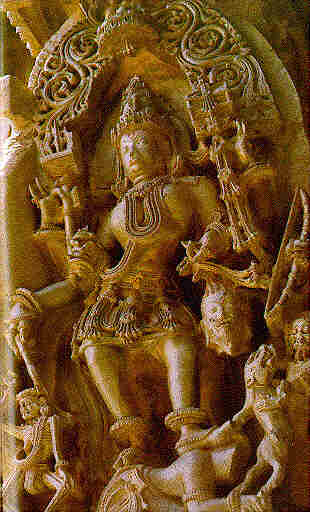 | In the mediaeval ages many kings and feudal lords
made generous donations to temples and temple construction. This is the reason for the rich opulent temples in the middle ages. Seen here is a statue of Shiva-Maheshwara at the Hoysaleshwara temple complex at Halebid in Karnataka. These temples date back to the 12th century C.E. |
As long as the centralised apparatus of the Mauryan state existed it could carry out the process of revenue collection but with the collapse of the empire and the disintegration of this centralised apparatus, this task became increasingly difficult. This created the necessity for an intermediate class between the tillers of the widespread farmlands and the sovereign monarch. The extension of farmlands on a scale that seemed almost limitless in those days along with the corresponding absence of a centralised tax collecting apparatus was one of the most important reasons for the emergence of intermediaries and the rise of feudalism.
Disappearance of the Shreni Guilds
This expansion of the physical dimensions of the agrarian economy required
the large scale supply of various commodities to the countryside . The apparatus of
the Arthashastra type with its heavy tolls at every Janapada frontier now became a
hindrance for the essential commodity movements due to large scale trade handled by private traders and not by the state as in Mauryan times.
The absence of
a central authority after the downfall of the Mauryan empire accounted
for the absence of good and secure means of transport to all
corners of the expanding settled territory. This became an
hindrance to extensive commerce.
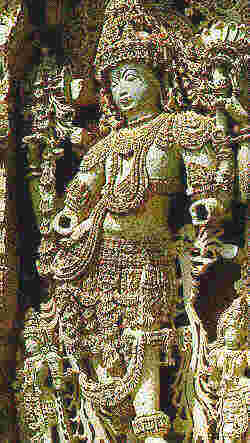 | The Opulence of Mediaeval Architecture. Seen here is a representation of Nandikesava - the bodyguard of Shiva-Maheshwara as depicted at the Hoysaleshwara Temple complex at Halebid. |
The only way to satisfy the village
demand was for the producer-artisans to move out of the centralized Shreni guilds and spread out into the countryside. With the strengthening of this tendency, the urban based centralised
production units of the Mauryan period began to disintegrate . So also did the till now cohesive Shreni guilds.
The Rise of the Self-Sufficient Village Economy
The individual producers who resulted from this falling mode of production, settled in the scattered villages throughout the countryside. In the absence of good means of communications. The village now began to get the characteristic of being itself self-sufficient closed economic unit which produced all its required commodities internally. Without any exchange or trade. While trade did exist it was a much smaller and irregular scale than it was in the Mauryan times. Thus while in Europe the coming of feudal relations in the middle
ages saw the rise of craftsmen-guilds, in India the rise of feudal relations was marked by the disintegration of the Shreni guilds.
Rise of a Class of Hereditary Revenue Collectors - the Feudal Lords
This shifting of economic activity was accompanied by the
shifting of political power to the rising class of village feudatory
revenue collectors who stood one above the other in a hierarchy in
place of the salaried bureaucrats who collected revenue for the
Mauryan State. In the changed circumstances the practice that was
gaining ground was of appointing revenue collectors who would
not be paid a salary by the king but who would be entitled to a share
in the revenue collected by him. Thus the position of a revenue
collector changed from being that of a salaried employee of the
king to that of a petty chieftain himself. Such hereditary revenue collectors were called "Samant". They also maintained a fighting force which could be called upon by the king when needed to defend or attack other kingdoms. The Samants were the feudal nobility.
 | The Caste System with its hereditary occupational structure
led to superb specialization.
Craftsmanship in the making of jewellery
from jade and other semi-precious stones
reached unparalleled heights in Medieval India. |
Role of Temples in Revenue Collection
When such revenue collectors were to be appointed for the first time,
the opposition of the tax paying tillers was smothered by making religious
institutions like temples, Ashrams, Viharas, Chaityas, etc., perform the
function of collecting revenue. Hence the practice of generous land grants to
temples, ashrams. individual Brahmins, etc. Along with the right to collect
revenue there was an obligation to pass on a part of the proceeds to
the king who had given the land grant. Only in rare cases was the
obligation to pass on part of the revenue to the donor-king was
waived. Thus these temples and monasteries served both as the
institutional and ideological arms for establishing this new mode
of revenue collection. Thus the administrative costs of
overcoming the opposition to this new revenue system was also
reduced by making ecclesiastical institutions as intermediaries.
Brahmadeya, Devadana and Agrahara Land Grants
These land grants were to religious institutions were called Brahmadeya, (i.e. donated to Brahmins) Devadana (donated to Gods) and Agrahara (Settlement - of priests)
These lands donated to the temples and monasteries
apart from being used as normal tenancy also carried a right
vested with the temple authorities to call for unpaid labour (called Vishti) as a religious service to the temple from the tillers on the donated land.
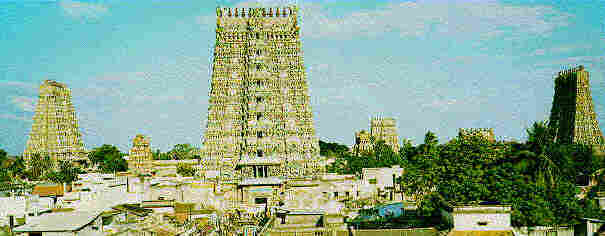 | The Madurai Temple Complex
is one of the most awesome of Medieval Hindu temples.
The Raj Gopurams (temple spires)
soar to a height above 180 feet. |
This unpaid labour, became an important method of enrichment of the intermediary revenue collectors, which the temples were, apart from having the rights of revenue collection.
Right to carry arms for the Nobility 'Samants'
But the physical muscle of this method of revenue collection through intermediaries, was the right to bear arms which
was given to the feudal lords and the petty local chieftains. These armed
feudal lords could be called upon by the king to render military
service to quell a rebellion to defend the kingdom from attack or to
launch an attack on neighbouring kingdoms.
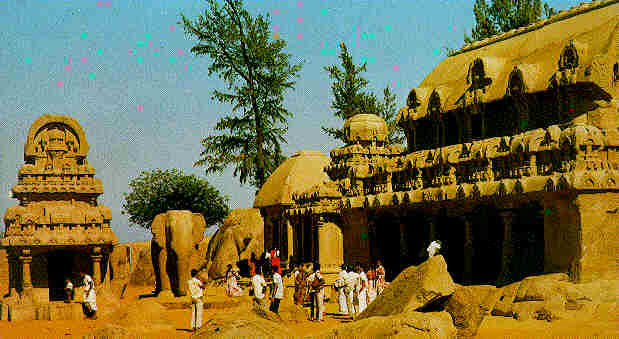 | A frieze from the rock-cut temples
at Mahabalipuram near Chennai.
These temples were created by the Pallava Kings in the 8th century. |
The armed retinue of every feudal
revenue collector-administrator was maintained out of the revenue
collected locally. Thus the local feudal lord was the paymaster of this
armed soldierly, and not the king whose kingdom they might be called on to
defend. This undermined the power of the king and we hear of rebellious nobles in this period. This was unthinkable during the centralized administration of Mauryan times.
Ultimately the maintenance of armed guards and the obligation to
render military service became the qualification for making grants of
land with revenue collection rights. These grants were made in recognition of
valour displayed by the various feudal lords in the battles in which the
particular kingdom was involved. The Jagirdari, Subahdari and Inamdari
grants of the Muslim period which came later were also of this type. But the feudal relations were established in the Post-Maurya period, much before the coming of the Muslims.
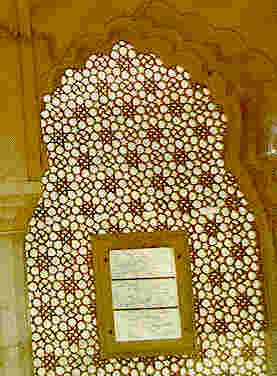 | Pierced marble Jalis (Filigrees)
were a specialty of medieval Rajput architecture. |
The King was at the mercy of his Noblemen
But the political consequences of this type of dependence of the king on the feudal lords in military matters often turned out to be unfortunate for those kings who did not have sufficient control over their vassals and their private armies of retainers. Many a times the vassals did not pass on the revenue collected to their king, this led to a perpetual struggle between
the king and the feudal lords under him. Often the feudal lords would switch
loyalties from one king to another whenever circumstances favoured this.
The
feudal system as a whole was characterised by the diffusion of executive
authority in the hands of innumerable petty chieftains vastly reducing
the absolute power of the king.
SUMMING UP of the Landholding Scenario in the Ancient Hindu (Pre-Muslim) Period
To sum up we can say in the period of 2200 years from the post-Vedic Period (i.e. 1000C.E.) upto the establishment of Muslim rule in India (around 1200C.E.) Indian socio-economic development passed through the following three stages.
The 1st Stage
In the post-Vedic age with the rise of caste divided society, to begin with, cattle and later largely land became the object of ownership. There existed large landholdings of two types - the first were the tribal oligarchies like the Mallas and Lichhavis as depicted in the Jataka stories. These oligarchies were eliminated by the pre-Mauryan monarchical states of Koshala and Magadha.
 | Generous donations from kings during the middle ages
led to the creation of artistic temple panels like this one.
The Trimutri.
This idol depicts the Hindu Trinity comprising
Brahma - the Creator,
Vishnu - the Preserver and
Mahesh (Shiva) - the Destroyer.
This statue is located at the Elephanta island near Mumbai. |
Alongwith these oligarchies in the hills, there existed on the plains within the kingdoms of Koshala and Magadha, large landed estates owned by absentee landlords. These were the second type of large land-holdings. Such absentee landlords are mentioned in the Pali text of Buddha's time. These absentee landlords had landholdings relatively near the monarchical states of the Ganges valley. As these landlords came under the sovereignty of the kings of Koshala and Magadha their landholdings came to be integrated with the prospering mercantile economy of these kingdoms.
In the Pali texts we find mention of landlord-merchants like Anathapindaka and Kossiyagotta. The state in whose territory these landlord-merchants lived also gained in the form of increasing collection of taxes and the general prosperity. In these monarchical states, the landlord-merchants played the role of intermediaries between the state and the actual tillers of the soil. Thus a nexus was established between the state and the landed aristocracy.
The corollary of these large estates of the absentee landlords were classes like the ardha-sitika share croppers. This indicates the existence of a society sharply polarised into two classes. Extensive landed estates in the Ganges Valley which were under private ownership were tilled by the labour of classes like the ardha-sitikas . Indepedent small peasantry seems to be largely absent in the civilized belt of the Ganges valley in that period.
The 2nd Stage
The imperialism of the Mauryas marked the second stage which led to the extinction of the big landowners and also of the urban merchants. The object of this was to eliminate centres of potential opposition to the state, through the almost complete elimination of this intermediate class between the state and the peasantry. The Mauryan state itself assumed the role of this class which it had successfully eliminated. But after the departure of the Mauryas and alongwith them of the highly centralised multifunctional administrative apparatus, a void was left between the state power and society (of peasant cultivators).
 | The Konark Sun Temple in Orissa.
This temple was erected by Narasimha Deva
the ruler of Orissa in the 13th century
to commemorate his victory over Tugan Khan
the Muslim Governor of Bengal. |
The 3rd Stage
The filling up of this void marks the beginning of the third stage. This void was filled up by the policy of giving land grant; followed by the emperors in the post-Maurya period and continued by the Gupta and Post-Gupta Kings. The titles assumed by the Gupta kings also indicate that they ruled their large empire by proxy. The Gupta kings did not call themselves Samrat as Ashok Maurya and Chandragupta Maurya were called. The titles of the Gupta kings like Samudragupta and Vikramaditya included Param-Eshwara (The Greatest - God), Param-Bhattaraka (The Greatest - Protector of the Brahmins), Maharaj-Dhi-Raj (King of Kings). All this indicates that the Gupta kings recognised themselves not as undisputed absolute monarchs, but as Chieftains of many other lower (and defeated) chieftains who paid tribute to the Guptas.
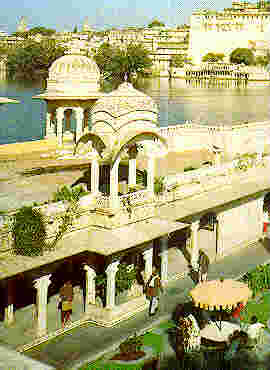 | These Chattris (Marble Cenotaphs)at Udaipur
represent an unique style of architecture
in Medieval India |
But now the social relationships
were of a qualitatively different nature than those prevailing in the pre-Maurya period. During the Maurya period too land was granted to farmer cultivators. But what was granted was not the right of revenue collection, but the right to cultivate and pay a part of the produce to the Mauryan state in the form of tax. The land grantees of the Gupta age were not owners of the lands and the villages granted to them. They were not interested in actual cultivation of the land themselves. They were only invested with the rights of revenue collection and exacting of forced labour, etc. A part of this revenue collected they gave to their overlord - the Gupta Emperor. In this respect they were neither land-owning aristocrats, nor were they absentee landlords, they were feudal intermediaries between the state and the peasantry.
 | Craftsmanship in the making of jewellery boxes
from beaten metal and teakwood
reached unparalleled heights in Medieval India. |
It can thus roughly be summed up that in the pre-Mauryan period the landholding class in the tribal oligarchies comprised mostly the Kshatriyas. This must have been so as the passage from a tribal to a settled agrarian society the social class that could have established, through muscle power, its ownership over property (mainly land in an agrarian society) would have been that which wielded arms.(But in the kingdoms they seem to have been mainly Vaishyas like Kossiyagotta and Anathapindika).
In the later periods i.e. in the Gupta and Post-Gupta Periods, the grantees must have been largely, though not necessarily individual Brahmins and temples as they constituted the class which commanded royal patronage and had a lesser tendency to rebel against the king, unlike the nobility which had a martial attitude. The temples also exercised religious influence and hence were most acceptable as revenue collectors to the God-fearing peasantry.
These land grants along with the rights of revenue collection and the free forced-labour services of nearby villagers and the generous offerings of devotees had made Hindu. temples
into conglomorates of vast collections of wealth in terms of gold, silver, gems, artifacts apart from acres of land and the rights of revenue collection.
 | Art in the middle ages was religious in expression
Krishna - the God of Music
is shown with his flute (Bansuri)
Krishna represented as a playful and romantic personality
is a favourite God among the Hindus. |
_________________________________________
Now we move on to examine India's Raj Namavali This term stands for the political happenings that shaped the above process of economic and social development of India in the Post-Maurya times. It also gives the list of dynasties that followed one another from the Post-Maurya times till the coming of the Muslims.
_____________________________________________________________
____________________________________View the Table of Contents
_________________________________________________
_______________________________________
_________________________________
With your visit this page has been visited  times since 5th May 1998
times since 5th May 1998












